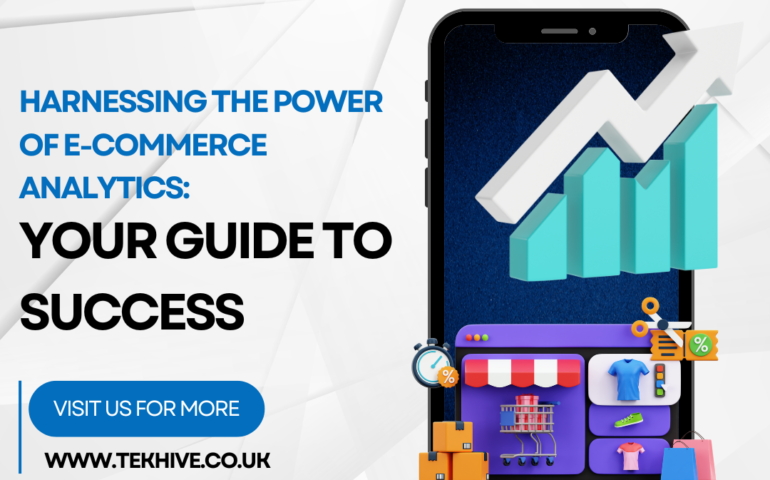
E-commerce Analytics

In today’s digital age, understanding your e-commerce data is crucial for success. It provides invaluable insights into customer behavior, sales trends, and overall performance. By leveraging these insights, businesses can make informed decisions, optimize strategies, and ultimately drive growth. In this comprehensive guide, we’ll delve into the importance of e-commerce analytics, explore essential tools, and share best practices to help you unlock your business’s potential.
Why it Matters?
Firstly, let’s discuss why e-commerce analytics is so important. For one, it allows you to understand your customers on a deeper level. By analyzing data such as purchasing patterns, browsing behaviors, and demographics, you can tailor your marketing efforts to better meet customer needs. Moreover, e-commerce analytics helps identify which products are performing well and which are not, enabling you to make smarter inventory decisions.
Additionally, e-commerce analytics provides insights into your website’s performance. Metrics like bounce rate, conversion rate, and average session duration can reveal how effective your site is at engaging and converting visitors. This information is vital for improving user experience and increasing sales.
Essential Tools
To harness the power of e-commerce analytics, you need the right tools. Here are some of the most essential ones:
- Google Analytics: This free tool offers a wealth of data on website traffic, user behavior, and more. It’s a must-have for any e-commerce business.
- Shopify Analytics: If you use Shopify, its built-in analytics tools provide detailed reports on sales, customer behavior, and more.
- Kissmetrics: This tool focuses on customer behavior and helps you understand how users interact with your site over time.
- Hotjar: By providing heatmaps and session recordings, Hotjar allows you to see how users navigate your site, highlighting areas for improvement.
- Mixpanel: This advanced analytics tool tracks user interactions with your website and mobile apps, offering deep insights into user engagement and retention.
Best Practices for E-commerce Analytics
Now that you have the tools, let’s discuss some best practices for using e-commerce analytics effectively:
- Set Clear Goals: Before diving into the data, establish what you want to achieve. Whether it’s increasing sales, improving customer retention, or optimizing marketing campaigns, having clear goals will guide your analysis.
- Track Key Metrics: Focus on metrics that align with your goals. For instance, if your goal is to boost sales, track conversion rates, average order value, and revenue per visitor.
- Segment Your Audience: Different customer segments may have different behaviors and preferences. Segment your audience by factors like demographics, purchase history, and browsing behavior to gain more precise insights.
- Regularly Review and Adjust: E-commerce analytics is not a one-time task. Regularly review your data and adjust your strategies accordingly. This ongoing process ensures you stay on top of trends and continuously optimize your business.
- Use A/B Testing: Test different versions of your website, marketing emails, and ads to see which performs better. A/B testing helps you make data-driven decisions and improve your overall effectiveness.
Common Challenges and How to Overcome Them
While it offers many benefits, it also comes with challenges. Here are some common ones and how to overcome them:
- Data Overload: With so much data available, it can be overwhelming to know where to start. Focus on key metrics that align with your goals and gradually expand your analysis as you become more comfortable.
- Data Accuracy: Inaccurate data can lead to misguided decisions. Ensure your tracking tools are set up correctly and regularly audit your data to maintain accuracy.
- Integrating Data Sources: Combining data from different sources can be tricky. Use tools that integrate well with your existing systems, and consider a centralized analytics platform to streamline the process.
- Interpreting Data: Data is only useful if you can interpret it correctly. Invest in training or consult with analytics experts to ensure you’re making the most of your data.
The Future of E-commerce Analytics
Looking ahead, e-commerce analytics will continue to evolve. Emerging technologies like artificial intelligence and machine learning are already enhancing the capabilities of analytics tools, providing even deeper insights and predictive capabilities. Staying updated with these advancements will be crucial for maintaining a competitive edge.

E-commerce Analytics is a Powerful tool For Your Business
In summary, it is a powerful tool that can drive significant growth for your online business. By understanding its importance, leveraging the right tools, and following best practices, you can unlock valuable insights and make data-driven decisions. Remember, the key to success lies in continuously analyzing, learning, and adapting. Embrace e-commerce analytics, and watch your business thrive.
If you want to read more information about how to boost your website traffic, just visit –> TekHive





